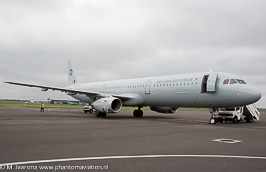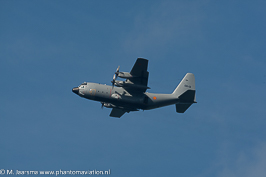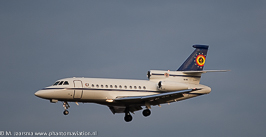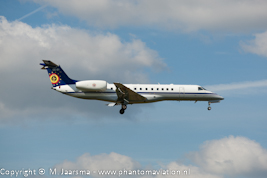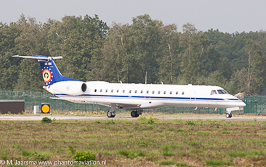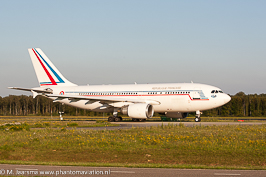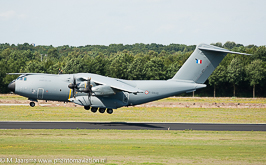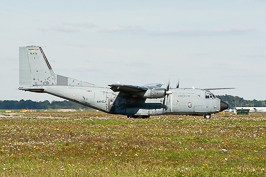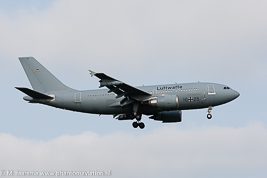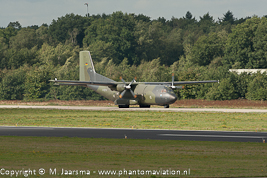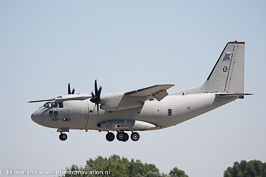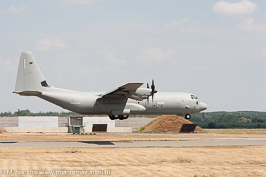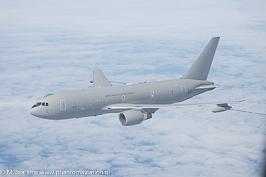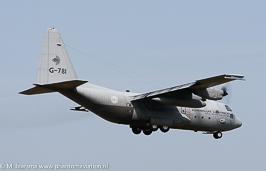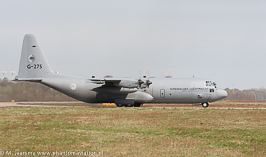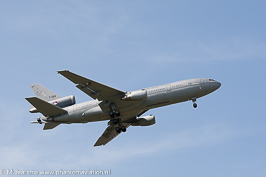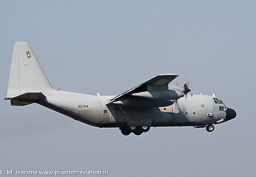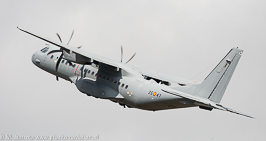The EATC was founded by Belgium, France, Germany and The Netherlands on
September 1st, 2010 - with the goal to better utilize the
members states Air Transport (AT)- , Aeromedical Evacuation (AE)- and
Air-to-Air Refuelling (AAR) assets and missions. Right from the start in
2010 till the end of 2014 a number of successes have been achieved by
the EATC: It reached its Full Operational Capability on November 28th,
2013. Three new members, Luxembourg, Spain and Italy joined and lead to
a situation where more than 70% of all European AT aircraft are
conducted under the Operational Command (OPCON) of the EATC.
The EATC Functional Division also plays an important role in the
successful introduction of the Airbus Defence & Space A400M. EATC is
also a European Defence Agency (EDA) partner in the lead of different
measures to find short term solutions overcoming the European AAR
shortfall. One measure led to the first dedicated European AAR training
exercise (EART) held at Eindhoven Air Base in April 2014. EATC is
located at Eindhoven Air Base, also home of Royal Netherlands Air Force
334 and 336 squadrons equipped with the KDC-10, Gulfstream IV and C-130
Hercules.
The command structure above the EATC organization is the Multinational
Air Transport Committee which is better known as MATraC. Each member
nation is represented by its Air Chief. MATraC is currently lead by
Dutch Lieutenant General Alexander Schnitger.
ATC command is being rotated between France and Germany every two years
and lead by a Major-General. From July 2014 German Air Force
Major-General Christian Badia took over command from French
Major-General Pascal Valentin. At the same time the Chief of Staff
position changed as well between the two countries. EATC consists of a
Functional and Operational division which itself are divided into
branches. The divisions are commanded by either a Belgian or Dutch
Colonel with their deputy assigned from another nation. These positions
rotate every three years.
Operational division branches: Long Term Planning, Tasking, Mission
Control, Intel, Aeromedical
Evacuation Control Centre (AECC) and Management of European Air
Transport (MEAT).
Functional division branches: Training & Exercise, Technical & Logistics
and Employment.
Within the Functional Division the staff members
are working on procedures for the fleet or aircraft controlled by EATC.
At current a lot of work is related to the introduction of the Airbus
Defence & Space A400M into service.
The French Air Force was the first to receive the new transport
aircraft and has received six by the end of December 2014. The German
Air Force saw its first A400M delivered in December 19th. Of
the aircraft for the French Air Force all except one are flying under
EATC OPCON.
Belgium with Luxembourg
and Spain also purchased the
airlifter and are awaiting delivery (see notes at the squadron and wing
overview.
Manuals and procedures written by technical
and logistic branch can directly
be used by the other national partners thus saving valuable time,
resources and money. Another accomplishment of the Functional Division
was made in harmonizing the rest times for the aircrews of the
participation nations.
Within the EATC member states, these rules are now the same for each
type operated and countries joining EATC will also adapt these rules
into their squadrons The Functional Division also succeeded in
implementing a system to easier
achieve diplomatic clearances (DC), needed to overfly all countries in
the path of the planned flight. Normally a DC is granted on a bilateral
agreement between two countries. Within EATC countries the AT-aircraft
can operate free flights into each other’s airspace. This way of
cooperation didn’t stay unnoticed and the European Defence Agency (EDA)
is working on a similar program extending the procedure to all European
nations. The United States also benefits from the work conducted by
EATC. Where in the past several DCs had to be requested, now they need
only one to overfly EATC countries.
Royal Netherlands Air Force Captain Coert van Putten worked at Eindhoven
Air Base and transferred to EATC right from the start in 2010 - serving
as planner, tasker and supervisor of mission preparation.
His current role is Tasking Officer for AAR-missions.
The Air Transport (AT) and AAR process is the same for all member
nations. As an example see below AT request
for a Dutch military unit (remark: within EATC the requests for
AT/AAR are received by each nations national transportation department).
“Mission preparation and planning takes place within the Operational
Division, afterwards Mission Control monitors all actual flights. A
request for AT by one of the Dutch Armed services (Air Force, Navy,
Army, Marines, and Military Police) has to be send first to the Defensie
Verkeers & Vervoers Organisatie (DVVO – Defence Traffic & Transport
Organization). They use four modules which are: transportation by road,
water, rail and air. Depending on the destination the request might lead
to a mix of the modules. Depending on the urgency, time and range,
equipment can also be moved by rail or truck to a harbor and then being
shipped to its destination – but then continue by truck, rail or air.
When the transport request leads to a decision to movement by air, the
DVVO creates an Air Transport Request (ATR). This request is entered in
the EATC application called MEAT (Management of European Air Transport).
The ATR contains modules for: Passenger (PAX), Cargo, Ammunition,
Hazardous Materials, VIP and Aeromedical Evacuation. It also states the
departure and destination air field, and requests either an arrival or
departure time. The DVVO for instance can request an arrival date and
time at Eindhoven Air Base. The request is then picked up within EATC
where the ATR checkers validate all required fields - having been filled
out to correctly process the ATR. When the ATR is completed, the status
is changed into ‘In Process’. The next step is a check, whether a flight
already exists and can be combined with the new ATR.
If that is the case but the flight is already planned with
another arrival time, EATC will report to the DVVO that this flight is
an option. Should this flight not be an option for the DVVO, the ATR is
treated as a new mission and therewith send over to Mission Preparation
Section (part of the Tasking Branch).
This Tasking Branch is divided into the following cells (sections):
| Stategic: |
Flights operated e.g. by the different A310, A340, A321 and
KDC-10. |
| Tactical: |
Flights operated by the CN235, C-130 and C-160, in future
also A400M. |
| AAR: |
Flights operated mainly by A310 MRTT and KDC-10. |
| Corporate Flight: |
Flights operated by
Gulfstream IV, Falcon 20E/900, ERJ-135/145 |
| Mission Preparation: |
(see following text) |
he Mission Preparation Team validates the flying times, prepares the
diplomatic clearances for the over flight of countries and works out the
route to be flown (air crews are responsible for flying the actual
flight plan). The process of providing diplomatic clearances can last
several working days up to several weeks.
The total status of an ATR can
be followed by DVVO and provides the information whom to contact in case
there could be a need to request a change or update. All these
information is provided by the MEAT-software. It is available to all
EATC nations’ users. The DVVO can anytime monitor the request, as well
as the squadron to operate the flight.
EATC provided an example of a MEAT ATR-excerpt: green dots need to be
completed while the red triangles indicate that some tasks are still in
process: a kind of check-list to guarantees the quality management.
The status of an ATR changes from “In process” to “planned”, “launched”
(wheels off runway) and finally “executed”.
24 hours before the departure of
an aircraft the mission preparation team hand over its results to
Mission Control during a briefing and explains specific mission if
needed.
Mission Control is manned on a 24/7 basis 365 days/year. Every Friday
the briefing takes places for missions to be executed during the next
weekend including next Monday. Each mission will be discussed and
Mission Control can monitor all the items which still have a status red
(red triangle, see above).
Analysis and reporting is the last section of the Operational Division.
It is implemented right below the Operational Divisions Head. After a
mission has been executed, the aircrews fill out a form, providing
information to EATC about the last mission performance. As example, a
mission was planned for two hours, but actually turned out to take three
hours. EATC will investigate the reason and will try to solve recurring
issues accordingly.
With mutual feedback between EATC and aircrews, the lesson learned shall
improve further missions and therewith optimize future mission- planning
and execution.
When joining EATC, a new member nation agrees to transfer a significant
part of its AT-fleet. The Netherlands chose to transfer all AT- assets
right from the start. Belgium did same for its tactical and strategical
assets and from January 1st 2014 transferred its VIP fleet.
Germany transferred its Transall fleet as well as all A310 (PAX and
MRTT), but didn’t transfer their VIP aircraft (two A340, two CJ 319 and
four Global 5000). France transferred its C-130 and C-160 fleet, its
Casa CN 235s, two A340 and three A310. The Dassault 7X and 900 are
operated under national control as well as the entire KC-135 fleet due
to their assignment to the French Strategic Fleet. Another exception
takes place for aircraft based overseas, e.g. in Africa, Latin American
or Pacific regions. Spain withheld their VIP fleet (A310, Falcon 900)
but will transfer its Casa C-295M, three B-707 tankers as well as major
parts of their Hercules fleet. On December 4th, 2014 Italian Air Force
General Pasquale Preziosa signed the respective Note of Participation
which made Italy the seventh member of EATC. Work will now be started to
integrate the some of the Italian Air Force squadrons and its aircraft
under EATC OPCON which would see the actual transfer and share of
aircraft in January 2016. The Italian contribution will consist of the
following aircraft: Alenia-Aermacchi C-27J Spartan (7), Boeing KC-767A
(4), Lockheed-Martin C-130J/C-130J.30/KC-130J (all).
As the Italian Air Force is conducting a program to upgrade
aircraft to MC-27J ‘Gunship’ variant only seven C-27J will be
transferred to EATC OPCON. Alike their French and German colleagues the
Italian VIP operated aircraft missions (Airbus D&S A319CJ, Dassault
Falcon 7X and Falcon 900) have not been transferred to EATC.
Each country has the right to withdraw aircraft from the EATC assigned
pool by wish of the nation Air Chief – simply by emailing the request to
withdraw a national needed aircraft. This
procedure is called RTOA: Revoke of Transfer of Authority. Recalling
aircraft to national command occur often enough – but does not harm the
EATCs mission at all. Some examples: The Netherlands consulted EATC with
respect to already planned missions during the conflict in Libya when
NATO requested a Dutch tanker to support the AAR missions. It lead to
the withdrawal of one KDC-10 from EATC operations which was then NATO
tasked.
Challenges are also ahead for EATC. The A400M is currently being
fielded, but it will take several years before enough aircraft are
available. In the meantime the Transall aircraft from both France and
Germany are withdrawn from service – for example when they have reached
their maximum flying hours. Apart from their age, those aircraft were
designed for tactical troop transport in Cold War scenarios, though
nowadays are assigned to sometimes long range transport missions.
At the end of the decade also the Dutch KDC-10 fleet needs to be
replaced. Within EDA, the Netherlands implemented a project group to
identify and purchase a new MRTT capable aircraft. On December 18th,
2014 it was announced by the
Netherlands MoD that the international cooperating project Multi Role
Tanker Transport will start a process to procure four Airbus D&S
A330MRTT aircraft. The participation nations (Netherlands, Norway and
Poland) strive to a signing the contract in 2016. That should lead to
the first aircraft being delivered in 2020. The purchase will be done by
NATO who will also be responsible of maintaining the aircraft. Eindhoven
air base is a potential candidate to house the MRTTs.
|
EATC squadrons and wing
overview
|
Below squadrons/wings are operated by the EATC for the member nations.
The overview includes the Italian Air Force see above. The Spanish Air
Force squadrons and aircraft will be transferred to EATC Operational
Control starting in April 2015.
| Country: |
Unit: |
Aircraft: |
Air Base: |
| |
|
|
|
| Belgium |
20 Smaldeel |
C-130H |
Melsbroek |
| |
21 Smaldeel |
A321, Falcon 20E, Falcon 900B, ERJ-135, ERJ-145 |
Melsbroek |
| |
|
|
|
| France |
ET 01.061
"Touraine" |
A400M |
Orléans |
| |
ET 02.061 "Franche
Comte" |
C-130H, C-130H.30 |
Orléans |
| |
ET 01.062 "Vercors" |
CN-235 |
Creil |
| |
ET 03.062 "Ventoux” |
CN-235 |
Creil |
| |
ET 01.064 "Bearn" |
C-160NG |
Evreux |
| |
ET 02.064 "Anjou" |
C-160NG |
Evreux |
| |
ET 03.060 “Esterel" |
A310, A340 |
Creil |
| |
|
|
|
| Germany |
LTG 61 |
C-160D |
Landsberg |
| |
LTG 62 |
A400M |
Wunstorf |
| |
LTG 63 |
C-160D |
Hohn |
| |
Special Air Mission Wing MoD |
A310PAX, A310MRTT |
Köln-Bonn |
| |
|
|
|
| Italy |
2° Gruppo, 50° Gruppo |
C-130J, C-130J.30, KC-130J |
Pisa San Giusto |
| |
8° Gruppo, 14° Stormo |
KC-767J |
Practica di Mare |
| |
98° Gruppo, 46 Brigata Area |
C-27J |
Pisa San Giusto |
| |
|
|
|
| Netherlands |
334 Squadron |
KDC-10, G-IV |
Eindhoven |
| |
336 Squadron |
C-130H, C-130H.30 |
Eindhoven |
| |
|
|
|
| Spain |
47 Gruppo |
B-707 |
Torrejón |
| |
Ala 31 |
C-130H, C-130H.30, KC-130H |
Zaragoza |
| |
Ala 35 |
C-295M |
Getafe |
Planned delivery dates for the first A400M with expected number between
brackets provided by Airbus D&S:
Germany (53) first delivered December 2014.
Spain (27) first quarter 2016.
Belgium (7) and Luxembourg (1) in 2018.
|
EDA and the Dutch lead
in AAR matters
|
At the end of the decade the Dutch KDC-10 fleet needs to be replaced.
France still uses older Transall and (not EATC assigned) KC 135
aircraft, Germany adds its Airbus A310 MRTT, Spain its older KC 707.
This comprises today the EATC assigned tanker fleet. Within EDA, four
project groups were implemented to overcome the European lack on tanker
resources. One project group is lead by the Netherlands in order to
identify and purchase a new MRTT capable aircraft. On December 18th,
2014 it was announced by the
Netherlands MoD that the international cooperating project Multi Role
Tanker Transport will start a process to procure four Airbus D&S
A330MRTT aircraft. The participation nations (Netherlands, Norway and
Poland) strive to a signing of the contract in 2016. That should lead to
the first aircraft being delivered in 2020. The purchase will be done by
NATO who will also be responsible of maintaining the aircraft. Eindhoven
Air Base is a potential candidate to house the MRTTs.
The author would like to thank EATC Captain Coert and Capt Norbert
Thomas for their contribution to write the article. |


